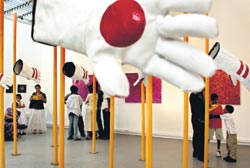
Under siege! - The artist as a chronicler of local realitiesChandraguptha Thenuwera’s Neo - Barrelism, an exhibition of paintings and installations at the Lionel Wendt Gallery, Colombo last month. Some artists are chroniclers of local realities and Chandragupta Thenuwara does it well, capturing the dilemma of life under the threat of terrorism and war. His recent exhibition, Neo-Barrelism, at the Lionel Wendt Gallery, offered plenty of fodder for thought on aspects of life under siege that have become so commonplace that many have grown immune to their significance.
What is happening today? Thenuwara asked. White gloved hands of security officers riding in armed vehicles wave us off the road to make way for important people. The installation in the centre of the gallery, a white clothed rectangle above which dangled two neat rows of white gloves, said it well. The strange ensemble also resembled a scene from a morgue or hospital. Further, the eerie white gloves waving like dismembered hands served as a morbid reminder of the incidence of sinister deaths and abductions in the country. The opposite ends of the room were occupied by sets of three large speckled abstracts. The first set was of nil manel, the national flower of Sri Lanka, and the second on the opposite end was of niyangala , the flower of the Eelamists. Each set comprised a canvas of budding flowers, a canvas of blossoming flowers and a canvas of dying flowers. The withering niyangala blossoms seemed to leave behind bloodied imprints. The agony of their death echoed the poisonous nature of the niyangala. Both lengths of the walls were taken up by large camouflage canvases. A single canvas depicted a barricade. Tall poles painted in fluorescent yellow were placed in neat rows, each a few feet apart, on the floor obstructing easy movement of guests. The poles represented a deconstructed barricade, reminding people that the loss of the freedom of movement is also part of their reality in the country. A single work in the corner of the hall titled ‘Incomplete list of Killings’ named people killed in the war starting with Alfred Duraiyappah (July 27, 1975) and ending with Herath Abeyweera (July 16, 2007). This list is by no means complete, Thenuwera stated. The list was flanked by two sign boards – one reading No Terror and the other Democracy Only. The irony was stark. Thenuwera made strong statements in this seemingly innocent and even playful collection of new works. That’s the power of good art. Neo-barrelism depicts the new era of barrelism, when, according to the artist, ‘the majority of the people in the South gave power to those who promised peace.’ Neo-barrelism is the ‘peace’ they found. Barrelism was the 'ism' given to his earlier collection which chronicled the era when barrels first appeared on the streets. Neo-barrelism moves forward to the era when barrels are supplemented with other restrictive implements such as yellow barriers and “no parking” and “one way” signs. Sri Lanka has progressed, past the pre-barrel era characterized by garlands of flaming tyres, to a new fortified state of existence. To appreciate this exhibition, one had to study the trees as well as the woods, experience a walk through the large hall hampered by ‘roadblocks’ and ponder on the symbolism of the camouflage uniforms, the dying nil manel and niyangala and the unfinished list of the dead. The whole was the sum of the individual pieces. Overall, it made me think and fill in the gaps with other implements not found in the gallery. What is happening today? asked Thenuwera. After taking in the exhibition, you could say, “This is the reality of today.” Thenuwera chronicled it brilliantly. |
|| Front
Page | News | Editorial | Columns | Sports | Plus | Financial
Times | International | Mirror | TV
Times | Funday
Times || |
| |
Copyright
2007 Wijeya
Newspapers Ltd.Colombo. Sri Lanka. |
